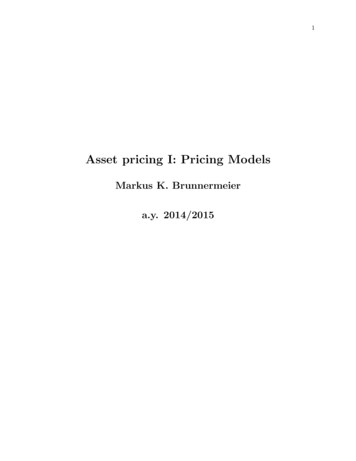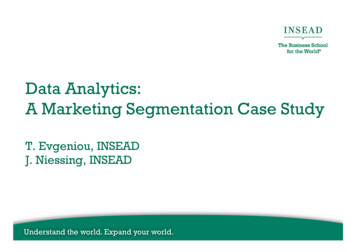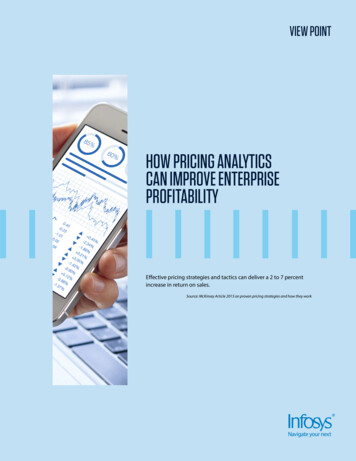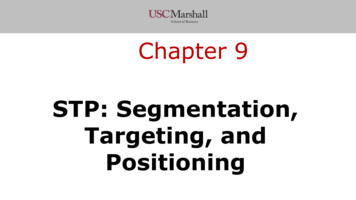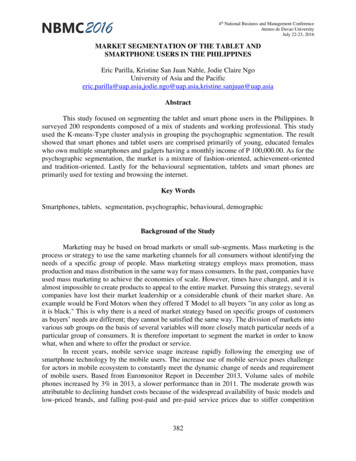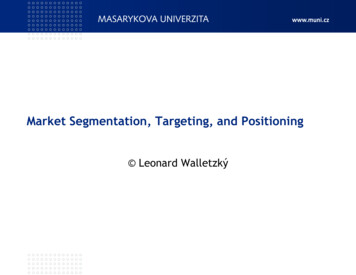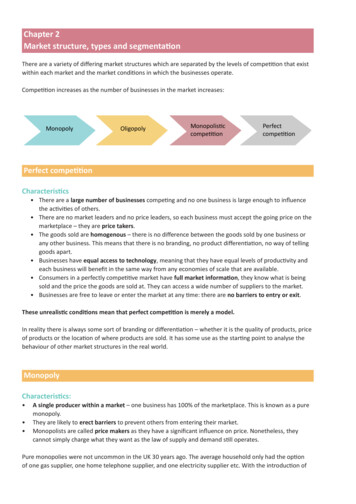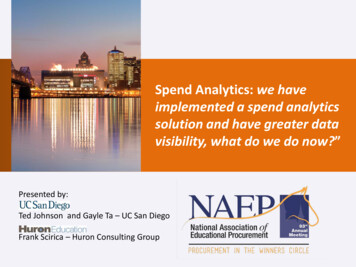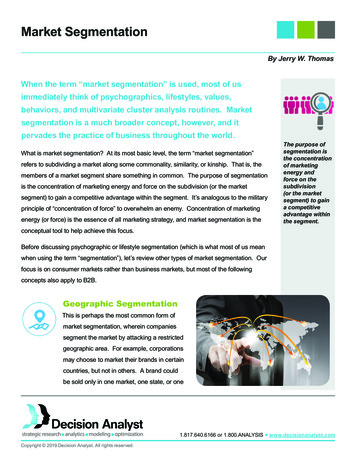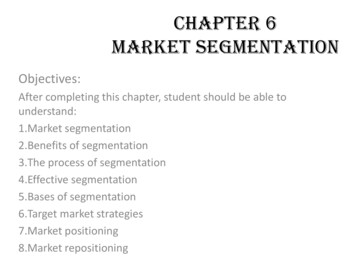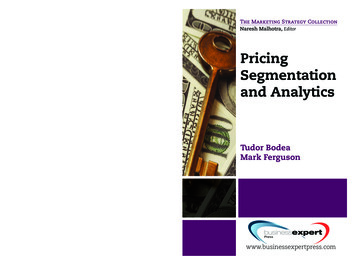
Transcription
Tudor Bodea and Mark FergusonTudor Bodea is an assistant professor in the operations groupat the University of Groningen, Faculty of Economics and Business. Prior to joining the University of Groningen, he was asenior scientist at Predictix and an operations research analystat InterContinental Hotels Group. He is six sigma certified and acontributor to R, an open source language and environment forstatistical computing and graphics.Mark Ferguson is the Wilbur S. Smith Professor in the MooreSchool of Business at the University of South Carolina. Prior tojoining the University of South Carolina, he was the Steven A.Denning Professor of Technology and Management at GeorgiaTech. He serves as the chair for the Pricing and Revenue Management subdivision of INFORMS, the president of the POMSCollege of Supply Chain Management, and he has consultedwith a number of companies on price optimization.Pricing Segmentation and AnalyticsPricing analytics uses historical sales data with mathematicaloptimization to set and update prices offered through variouschannels in order to maximize profit. With this outstanding contribution to this subject, you will learn just how to identify andexploit pricing opportunities in different business contexts.Each chapter looks at pricing from an economist’s viewpoint beginning with the basic concept of pricing analytics andwhat type of data are needed to use this powerful science; thecommon assumptions regarding the customer population’swillingness-to-pay are discussed along with the price-responsefunctions that result from these assumptions; examples fromseveral industries and organizations; dynamic pricing, with aspecial emphasis on the most common application—markdownpricing; the new field of customized pricing analytics, wherea firm responds to a request-for-bids or request-for-proposalswith a customized price response; and the relevant aspects ofbehavioral science to pricing. Additional examples include theasymmetry of joy/pain that customers feel in response to pricedecreases/increases.bodea FergusonPricing Segmentation and AnalyticsThe Marketing Strategy CollectionNaresh Malhotra, EditorPricingSegmentationand AnalyticsTudor BodeaMark FergusonThe Marketing Strategy CollectionNaresh Malhotra, EditorISBN: 978-1-60649-257-490000www.businessexpertpress.com9 781606 492574www.businessexpertpress.com
Pricing Segmentationand Analytics
Pricing Segmentationand AnalyticsTudor Bodea and Mark Ferguson
Pricing Segmentation and AnalyticsCopyright Business Expert Press, LLC, 2012.All rights reserved. No part of this publication may be reproduced,stored in a retrieval system, or transmitted in any form or by anymeans— electronic, mechanical, photocopy, recording, or any otherexcept for brief quotations, not to exceed 400 words, without the priorpermission of the publisher.First published in 2012 byBusiness Expert Press, LLC222 East 46th Street, New York, NY 10017www.businessexpertpress.comISBN- 13: 978- 1- 60649- 257- 4 (paperback)ISBN- 13: 978- 1- 60649- 258- 1 (e- book)DOI 10.4128/9781606492581A publication in the Business Expert Press Marketing Strategy collectionCollection ISSN: 2150- 9654 (print)Collection ISSN: 2150- 9662 (electronic)Cover design by Jonathan PennellInterior design by Scribe Inc.First edition: January 201210 9 8 7 6 5 4 3 2 1Printed in the United States of America.
AbstractPricing analytics uses historical sales data with mathematical optimization to set and update prices offered through various channels in orderto maximize profit. A familiar example is the passenger airline industry,where a carrier may sell seats on the same flight at many different prices.Pricing analytics practices have transformed the transportation and hospitality industries and are increasingly important in industries as diverseas retail, telecommunications, banking, health care, and manufacturing.The aim of this book is to guide students and professionals on how toidentify and exploit pricing opportunities in different business contexts.The first chapter looks at pricing from an economist’s viewpoint,beginning with the basic concept of pricing analytics and what type ofdata are needed to use this powerful science. Next, the common assumptions regarding the customer population’s willingness- to- pay are discussedalong with the price- response functions that result from this assumption.From the price- response functions, we show how to estimate price elasticity and how it differs at the product, firm, and industry levels as well asin the short term versus long term. Basic price optimization techniquesare then explored.The second chapter looks at these same topics but from a more practical standpoint, with examples provided from several industries andorganizations.The third chapter is on dynamic pricing, with a special emphasis onthe most common application: markdown pricing. Similar to the firsttwo chapters, both the theory and the application aspects will be covered.The fourth chapter covers the new field of customized pricing analytics, where a firm responds to a request- for- bids or request- for- proposalswith a customized price response. In this situation, the firm only has historical win/loss data, and traditional methods involving price elasticity donot apply. The pricing analytics methodology is described in a step- by- step process from an actual application.The final chapter covers the relevant aspects of behavioral science topricing. Examples include the asymmetry of joy/pain that customers feelin response to price decreases/increases. A set of best pricing practicesare provided based on these behavioral responses. Finally, the appendices
contain more details on the commonly used tool of logistic regressionand the open source statistical software environment R.KeywordsSegmentation, revenue management, price optimization, price elasticity,promotions, pricing
ContentsChapter 1Theory of Pricing Analytics. . . . . . . . . . . . . . . . . . . . . . 1Chapter 2The Practice of Pricing Analytics. . . . . . . . . . . . . . . . . 25Chapter 3Dynamic Pricing and Markdown Optimization. . . . . . 61Chapter 4Pricing in Business- to- Business Environments. . . . . . . 85Chapter 5Customer Behavior Aspects of Pricing. . . . . . . . . . . . 101Appendix A Dichotomous Logistic Regression . . . . . . . . . . . . . . . 111Appendix B Pricing Analytics Using R . . . . . . . . . . . . . . . . . . . . . 121Notes. . . . . . . . . . . . . . . . . . . . . . . . . . . . . . . . . . . . . . . . . . . . . . . . 143References . . . . . . . . . . . . . . . . . . . . . . . . . . . . . . . . . . . . . . . . . . . . 147Index . . . . . . . . . . . . . . . . . . . . . . . . . . . . . . . . . . . . . . . . . . . . . . . 153
I would like to thank my coauthors, colleagues, and studentswho have helped me learn and explore this exciting topic.Special thanks goes to my wife Kathy, and daughters Graceand Tate, for their love, encouragement, and support.— Mark FergusonI would like to thank my coauthors and former colleaguesat InterContinental Hotels Group and Predictix for offeringme the opportunity to work with them. I would also like toacknowledge the debt I owe to my family—I have becomewho I am because of them.— Tudor Bodea
To all those who inspired and believed in us— we are grateful for all your support.
Chapter 1Theory of Pricing AnalyticsHow do managers in a firm decide on the prices to charge for the products or services they sell? For some firms, the pricing decision is made atthe top level of the management team with little flexibility for the salesforce, marketing team, or supply chain partners (distributors or retailers)to make adjustments. Apple’s fixed pricing for its popular iPhone andiPad products is a good example of this practice. For other firms, it mayappear to the customer that pricing is left entirely up to the individualsales person. This happens frequently in the business- to- business (B2B)market, such as the pricing for a major software implementation by asoftware vendor or consulting company. The price quoted for a new carfrom a dealership is an example from the business- to- consumer (B2C)market. Even in these situations, however, there is almost always someprice guidance provided by a division level or corporate pricing team.Thus most large firms have some department or team whose primaryresponsibility is to determine the price, or price range, to charge for thefirm’s products. The group may reside under many different branches ofthe corporate organizational structure, such as marketing, operations, orfinance, and its members may or may not have pricing in their job titles.It is also common for this group of professionals to have access to somehistorical pricing and sales data, even if this information is not currentlybeing used in the price setting process.Pricing analytics involves the use of historical data to determine thebest prices to set for future sales. In this chapter, our focus is on the theorybehind pricing analytics. In the next chapter, we discuss how the practice ofpricing analytics may sometimes differ from the theory. Our focus in bothof these chapters is on the setting of a base price for a single product. Anexample would be the regular price to charge for a nonperishable productFor consistency and where appropriate, we use the same notation in this chapter asPhillips (2005a).
2Pricing Segmentation and Analyticssold through a retail store. We cover more specific applications of pricing analytics such as dynamic pricing, markdown pricing, and customizedB2B pricing in later chapters. We also save our discussion of the importanttopic of behavioral responses to pricing for a later chapter. While it is oftendifficult to apply the techniques described in this chapter directly, a goodunderstanding of the theory behind pricing analytics is crucial to successful applications of the techniques described later in the book.The Microeconomists’ View ofConsumer- Purchasing DecisionsWhat makes a consumer decide to purchase a product or to choose oneproduct over all the other alternatives? Economists use the term consumerutility to represent the value that a particular product or service providesto a customer. Utility is often represented in monetary values. For example, at a particular point in time, a consumer may derive a utility of 1 fora can of Coca- Cola and a utility of 0.90 from a can of Pepsi.Willingness- to- PayAnother term that is commonly used in the pricing field is the consumer’smaximum willingness- to- pay (WTP), or the maximum price at which theconsumer would buy a good. Often, consumer utility and willingness- to- pay are terms that are used interchangeably. Thus if the consumer isat a store that only sells cans of Coca- Cola, microeconomic theory saysthat the consumer will purchase a can if the price is less than or equal to 1 (we are assuming away budget constraints in this example, i.e., theconsumer is not prohibited from purchasing the product because of budgetary constraints). If the store sells cans of both Coca- Cola and Pepsi,then the consumer will purchase the brand that maximizes her remainingutility after subtracting the purchase price. For example, if a can of Coca- Cola is priced at 0.75 but a can of Pepsi is 0.50, then the customerpurchases the can of Pepsi because ( 0.90 – 0.50) ( 1.00 – 0.75).Consumer Search CostIn addition to a side- by- side comparison of the prices of different brandsof a particular product, consumers are often aware that alternative brands
Theory of Pricing Analytics3or prices are available at other locations or through other channels. Inthe previous example, we assumed that the consumer will purchase oneof the brands of soda from the store she is currently in. Suppose, however, that the consumer knows that the store across the street sells cansof Pepsi for 0.40. Will the consumer delay the purchase of a can ofsoda and cross the street to save an extra 0.10? To answer this question,economists have defined a “search cost” to represent the hassle of searching and purchasing the product from another location or source. Thusthe consumer will still purchase the can of Pepsi from the store as long as( 0.90 – 0.50) ( 0.90 – 0.40 – search cost).What makes pricing challenging is that a particular customer’s utilityfor products may change over time depending on factors such as the season, the weather, the overall economic climate, or the current competitiveenvironment in our industry. In addition, different consumers typicallyhave different WTPs and different search costs (termed heterogeneous customers in the economics literature), and we seldom have the capability toset a personalized price for each specific consumer. Even if we did havethe capability to set customized prices for each specific consumer, they donot make it a practice to tell us what their utilities are for our products.This is rational; consumers recognize that firms that know their maximum WTP for a product can set a specific price for each consumer equalto that consumer’s maximum WTP. Thus the practice of pricing analyticshas evolved to improve upon historical pricing performance while takinginto account the realities mentioned earlier.The Pricing Analytics ProcessPricing analytics is an iterative process using historical price/demand datato adjust the price of a product in order to maximize profits by analyzing the trade- off among price, volume, and cost. In general, the field hasmoved toward the term price analytics and away from the term price optimization because optimization implies that it is possible to analyticallydetermine the single price that will maximize profits with a reasonabledegree of confidence. In practice, there is always uncertainty aboutwhether a given price is the “right” price. Still, approximating the optimal price is the goal. Determining the profit- maximizing price requires acombination of analytical rigor and man
He serves as the chair for the Pricing and Revenue Man-agement subdivision of INFORMS, the president of the POMS College of Supply Chain Management, and he has consulted with a number of companies on price optimization. Pricing Seg M en TAT ion A nd An A ly T ic S bodea Ferguson iSBn 9 78 1 60 42 5 9 0 0 0 0 www.businessexpertpress.com The Marketing Strategy Collection
